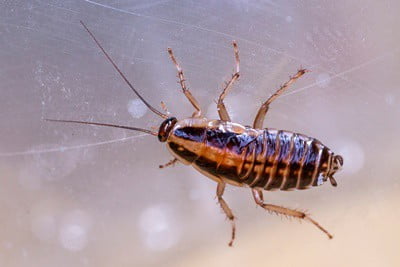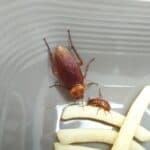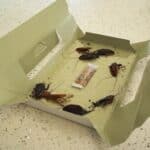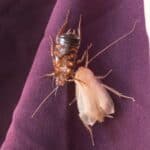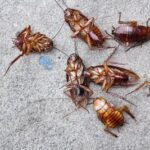Cockroaches have defensive capabilities that can drive off predators and protect them from harm. Some tactics are even designed to confuse enemies so that they have time to escape. While house roaches have a limited number of protections, wild species can change color, hiss, and spray chemicals.
Cockroaches defend themselves by running, jumping, or flying. They can run up to 3 mph, jump as far as 50 body lengths, and fly at 3.4 mph. They can pretend to be dead until the predator leaves them alone. Certain species can bury themselves in the ground, flash warning colors, or mimic their enemies’ colors.
The greatest defense a cockroach has is its exoskeleton. This hard shell allows them to survive being crushed, bitten, or thrown. Some predators find the armor plating difficult to bite through or digest. Roaches have also evolved more unique ways of surviving, such as keeping eggs inside their bodies to hatch safely.
How Do Cockroaches Defend Themselves?
Cockroaches may be prey animals, but that doesn’t mean that they’re helpless. They pair their resilience with defensive tactics to outwit their predators. Even their behavior is custom-tuned to drive off enemies.
Running
Running is the best defense that cockroaches have against predators. At the first sign of danger, they can run away at 3 mph. If you were to scale this up to a human’s size, it’s the equivalent of several hundred miles an hour. This is true even for nymphs (their young), which can match an adult’s speed despite their diminutive size.
Cockroaches have 6 legs and 18 knees, giving them impressive dexterity. Even better, just like horses can switch from a trot to a gallop, cockroaches too can add an extra burst of speed.
According to the Journal of Comparative Physiology, this speed is reached by altering the movement of their legs in relation to each other. Cockroaches may even rise on their back legs when running to be more aerodynamic.
Jumping or Flying
Legs account for 20% of a roach’s weight and have many muscles, each with its own function. According to the Journal of Experimental Biology, this allows roaches to conserve energy, despite outputting a great deal of force.
Cockroaches use this extra power to be impressive jumpers, able to leap up to 50 body lengths in one go. That can be up to 8 or 12 feet, depending on the species and if the cockroach has a good angle.
These leaps are made possible due to a roach’s wings. They can fly at 3.4 mph or at least flutter short distances if the wings aren’t functional. When predators corner roaches, they can use this to quickly escape, either by bounding out of reach or flying to higher ground. Not all roaches with wings can fly, such as the oriental cockroach.
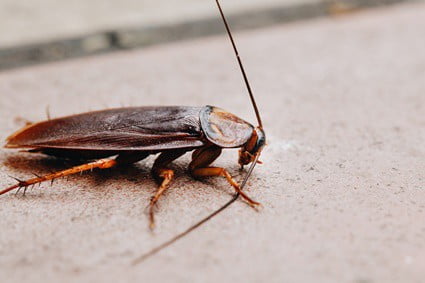
Walking On Walls
Across the roach’s legs, you’ll find tiny hairs and claws. These are used to grip onto flat surfaces to enable the cockroach to climb with ease. Cockroaches can scale walls, table legs, and most other vertical surfaces. This allows cockroaches to climb up trees in search of food or to escape danger.
Sensing Danger And Burying Themselves
Certain wild species of roach will burrow into the ground during their inactive period. This not only enables them to save energy, but it also hides them from predators. Should they encounter a threat during their active period, cockroaches will still dig into the earth for safety.
A cockroach need only detect an incoming predator with its antennae. These allow cockroaches to smell danger in the air or sense the vibration of incoming steps. In response, a cockroach will find soft earth and bury its head and body into the substratum.
This defense is most common for roaches that deal with other insects as predators. Those vulnerable to scorpions or centipedes may be able to outmaneuver the roach with its superior digging skills.
Camouflage
In other instances, roaches camouflage to avoid predators. Most species have dark brown or black colors, which easily blend with:
- Dead leaves
- Sharp spines on tree trunks
- Dark crevices in soil
The cockroaches of the Panchlora breed, also known as banana cockroaches, are green in color. This enables them to disguise themselves as leaves or green plants. Likewise, Prosoplecta cockroaches have the red and black color, just like ladybirds. This keeps predators away by showing off the colors that some animals recognize as poisonous.
Defensive Sprays
Sometimes, it only takes a foul odor to keep enemies away. That’s what pacific beetle cockroaches do by firing out defensive sprays to save their lives. The odor ejected from their body is offensive enough to drive off insects, birds, and certain mammals.
The pungent musk can even be nauseating. This will cause predators to feel ill, should they still try to eat the bug. At the minimum, it disorients the enemy and causes it to hesitate, giving the cockroach time to escape.
Noise
While most house roaches don’t make a noise, wild varieties can. This may sound like a chirp to attract mates or a startling hiss that will scare off enemies.
In particular, the Madagascar hissing cockroaches are known for producing a sharp, angry hiss. It’s loud enough to sound like a much bigger, more aggressive predator. This can startle away enemies that haven’t quite pinned down the hissing roach’s location.
Flashing Colors
Certain species of cockroach use aposematic coloration. This refers to changing colors or flashing certain colors at predators as a warning. Depending on the pattern and coloring, it can make the cockroach seem unpalatable. Either it’s too dangerous and may fight back, or it’s poisonous and not worth the meal.
This defense tactic is only found in wild cockroaches. A diurnally active cockroach with the scientific name of Platyzosteria reficeps shows bright orange markings when near possible enemies. Should its habitat be disturbed, it will secrete bright yellow and black aposematically colored fluids. These warning colors then scare off predators or make attackers think twice.
Copying Colors
Wild roaches can mimic the coloring of their enemies. This will confuse the predator, making it think that one of its own kind has appeared. Before the predator can investigate why its prey suddenly turned into a rival, the cockroach will flee to safety. This works best against enemies like Lampyridae beetles and certain wasps.
Freezing
When faced with an extreme threat or damage to its body, the cockroach’s body will release a hormone that effectively paralyzes it. This forces it to cease all movement.
Many of its predators, such as birds or reptiles, depend on movement to catch sight of their prey. If the insect suddenly quits moving and is unable to flinch, it’s essentially vanished.
However, this tactic doesn’t exist for all roaches, and it could make them vulnerable to other predators.
Chemical Defense
Aside from pungent odors, roaches can spray more dangerous chemicals to defend their lives. If threatened, certain breeds will secrete aliphatic compounds. In particular, these are trans-2-hexenal.
They can be ejected toward predators, and if they make contact, they’re extremely uncomfortable. According to the World Health Organization, cockroach spray is responsible for causing allergic reactions like:
- Dermatitis
- Itching
- Swelling of the eyelids
- Serious respiratory conditions
This can affect humans, insects, and animals alike. It only takes a small burst of this chemical to distract and irritate the predator. While it repels to deal with the problem, the roach can flee to safety.
Behavioral Adaptations Of A Cockroach
Roaches also pair certain behaviors with their physical defenses. That can ensure the mechanisms are more effective, or it can save the roach’s life all on its own.
Playing Dead
Even if a cockroach doesn’t have the hormone to freeze it solid, many are still talented at holding still and pretending to be dead. This has fooled many people into thinking that a crushed or poisoned cockroach is deceased.
Once it has decided that danger has passed, it will spring to its feet and run to safety. This feigning tactic can last for 15 minutes or more. However, the cockroach may give up the ploy early if it thinks there’s an opening to flee.
Rolling Up
Perisphaerus cockroaches can roll themselves into a ball to defend against predators. This works to shield their organs or more valuable body parts.
It also leaves their enemy with no choice but to struggle against their hard exoskeleton and thickly encased wings. Depending on the predator, it may be impossible to chew through or to swallow the cockroach in this state.
Why Do Cockroaches Have an Exoskeleton?
The most notable feature of a cockroach is its tough exoskeleton. Unlike mammals, cockroaches don’t have their skeleton on the inside of their body. Instead, it’s a thick shell that encases them, keeping their organs and tissue well protected. The structure is rigid and resistant. It can:
Protect Against Abrasion Or Physical Damage
The hard exoskeleton works as a shield for the organs and soft tissue. This means even getting stepped on, thrown around, or bitten won’t be a serious injury unless the shell is cracked. In practice, roaches are encased in armor.
Detection of Environmental Threats
Exoskeletons are covered with several layers of membrane. These all contain receptors that are responsible for tasting and smelling. Roaches gather sensory information about their environments through:
- Mechanoreceptors
- Chemoreceptors
- Photoreceptors
Those are all present in this outer layer. That means that cockroaches can use its shell alone to learn more about incoming danger, tasty food nearby, or upcoming weather changes.
Gross Out Certain Predators
The outer body of a roach is a mosaic of hard plates. These are incompatible with predators that don’t have a strong jaw. The crunch of squishing a roach isn’t appetizing, and the shell is not easily digestible to all insectivores.
As a plus, when attacked by predators, the hard exoskeleton won’t break easily. If the first bite doesn’t kill the cockroach, it gives it a chance to escape before the next bite.
Allow For Complex Movement
Despite being hard armor, exoskeletons are designed with flexible joints that connect with the cockroach’s underlying muscles. This allows for a wide range of movement and motion.
The body is divided into many segments, so each part receives different coverage from various pieces of the exoskeleton. This unique design enables a cockroach to stay alive even if some of the body is damaged or removed.
Protects Against Water
The exoskeleton works as a raincoat to deflect water and keep roaches dry, even when submerged. In fact, the spiracles that line the shell to allow cockroaches to breathe can seal up. This prevents them from drowning.
Cockroach Defense Mechanism In The Home
Of course, cockroaches don’t have to deal with many of their natural predators in your home. Instead, their main concerns will be the humans living there and the rest of their colony.
Because of that, roaches use only a few of their defense mechanisms. Common household species don’t even possess these more complex tactics. Changing color, hissing, or spraying chemicals are all non-existent in these cockroaches. Instead, house roaches will depend on more simplistic defense mechanisms, such as:
- Running
- Jumping
- Flying
- Playing dead
- Sensing incoming danger with their antennae
Why Do Cockroaches Fly at You?
While this may seem like a defensive action, it usually happens by accident. It’s not uncommon for you to experience a roach taking to the air and flying directly at you. This can seem like an attack, especially if it aims directly at your face.
While flight can be a defensive action, rarely do cockroaches purposefully aim for their enemies. Instead, cockroaches will only fly to escape from danger.
Cockroaches don’t have the greatest precision with their wings. Although they’re fast, they’re not well coordinated. It’s possible the roach was aiming for somewhere else and went off course. Unfortunately, that took it right toward you.
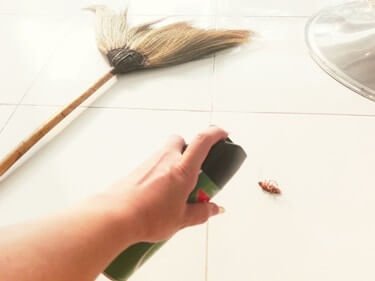
Do Cockroaches Fight Each Other?
Cockroaches are territorial creatures that are willing to fight other roaches. They may attack or kill one another over:
- Food sources
- Space
- Availability of females
However, the most common reasons for fighting between cockroaches are starvation and overcrowding. If they’re unable to carve out enough space for themselves, larger cockroaches will eat smaller ones. Likewise, if there isn’t enough food, cockroaches have no problem seeking nourishment in their colony members.
Why Are Cockroaches So Adaptable?
Cockroaches adapt to survive. They have been around for more than 300 million years because of their ability to change based on the challenges that life brings their way.
They not only survived the mass extinction event that wiped out the dinosaurs. They have even adapted to modern pesticides and developed traits to resist natural predators. If they didn’t, they would have been driven to extinction by pest control methods and dangerous environmental changes.
Cockroach Adaptations For Survival
Aside from the defense mechanisms they’ve evolved, the following adaptations have been made:
Poison Resistance
Pesticides are used to control cockroach populations in urban areas. However, they’re learning how to adapt to these poisons. In fact, according to the Asian Pacific Journal of Tropical Biomedicine, German cockroaches have developed a strong resistance to insecticides, such as:
- Organochloride
- Organophosphorus
- Carbamate
- Pyrethriode
Studies are finding that baby cockroaches are hatching with immunity to certain poisons. If their parents were exposed to a pesticide and survived, their bodies will internalize that in their genes. Once passed on to the next generation’s biochemical makeup, a built-in resistance will ensure that offspring won’t fall victim to that same poison.
Ovoviviparous Females
Certain species of cockroaches, such as hissing roaches, are ovoviviparous. This means that the females give birth to live hatchlings. This is an important adaptation to avoid the invasion of parasitic emerald wasps.
They lay their offspring in the egg case of roaches, killing them and using the larvae as food. By keeping the baby roaches safe inside the female, there’s a better chance of them surviving until the nymph stage.
Cockroaches have some impressive ways of defending themselves against predators. From running to spraying chemicals to even changing color, cockroaches are notoriously difficult to kill.
